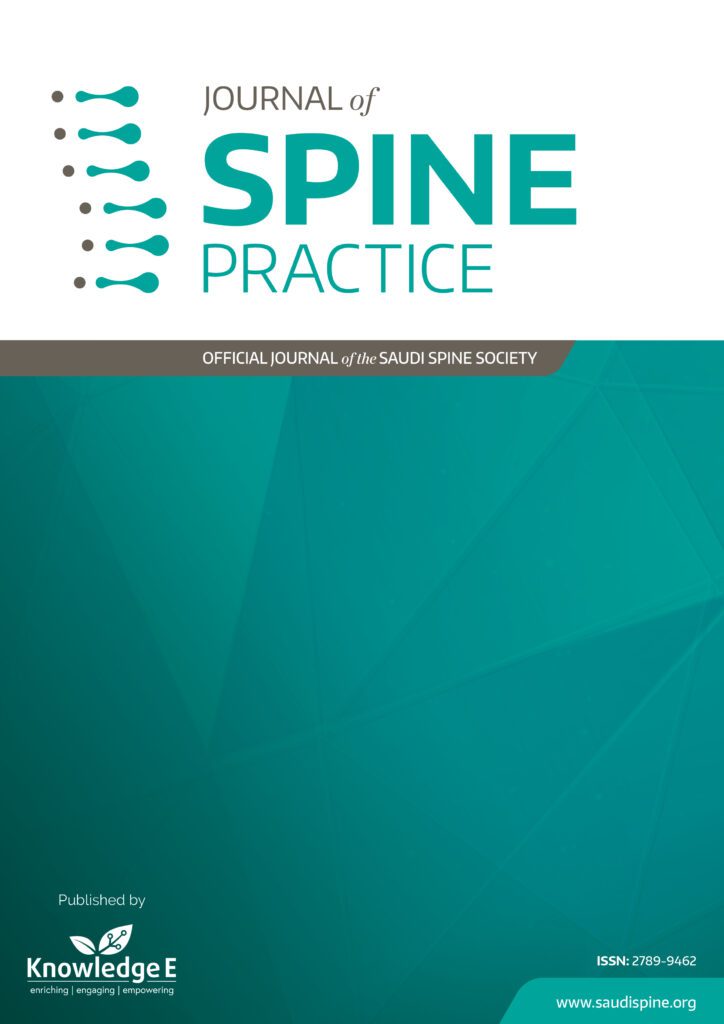
Journal of Spine Practice
ISSN: 2789-9462
Leading research in all spine subspecialties focusing on orthopaedic spine, neurosurgery, radiology, and pain management.
Extreme Lateral Interbody Fusion: An Observational Study of Functional and Radiological Outcome
Published date: Nov 20 2023
Journal Title: Journal of Spine Practice
Issue title: Journal of Spine Practice (JSP): Volume 3, Issue 1
Pages: 1 - 6
Authors:
Abstract:
Introduction: Extreme lateral interbody fusion (XLIF) constitutes a minimally invasive procedure employed to address a spectrum of conditions including degenerative disc disorders, trauma, infections, and deformities. Despite its potential, there exists a scarcity of studies exploring perioperative functional and radiological outcomes. This prospective observational study seeks to address this gap by reporting these outcomes in patients treated at the King Faisal Specialist Hospital & Research Centre (KFSHRC) over a mean follow-up period of 5 years.
Methods This case series amassed baseline patient data, encompassing gender, age, body mass index (BMI), American Society of Anesthesiology (ASA) classification, operated level, and posterior fixation type. Primary outcome measures encompassed the Oswestry Disability Index (ODI), Roland-Morris Disability Index (RMDI), Euro-Qol (EQ)-5D, visual analog scale (VAS), and EQ-5D index scores. Additionally, the study delved into secondary outcomes encompassing radiological parameters such as sagittal balance, lumbar lordosis, sacral slope, pelvic tilt, and pelvic incidence.
Results: The study embraced 51 patients, comprising 9 females and 42 males, with a mean age of 58.6 years and a mean BMI of 29.3. The patients were followed for an average of 5.2 years. Stratification according to ASA classification revealed that 11.8% of patients were classified as ASA I, 52.9% as ASA II, and 35.3% as ASA III. The levels of operation included 60.8% at L4-L5, 33.3% at L3-L4, and 5.9% at L2-L3. The fixation techniques employed encompassed 58.8% bilateral and 41.2% unilateral approaches. The analysis of the primary clinical outcomes unveiled statistically significant enhancements in ODI, RMDI, EQ-5D VAS, and EQ-5D index scores. While lumbar lordosis registered a significant decrease, radiological parameters indicated non-significant shifts in pelvic incidence, pelvic tilt, and sacral slope.
Conclusion The XLIF procedure emerges as an efficacious and minimally invasive avenue for managing degenerative disc disorders. The reported functional and radiological outcomes prove satisfactory. However, while demonstrably effective, the generation of clinical recommendations necessitates the compilation of results from randomized clinical trials.
Keywords: Extreme lateral interbody fusion, XLIF, Degenerative disc disorders, Spinal disorders
References:
[1] Mobbs R, Phan K, Malham G, et al.: Lumbar interbody fusion: techniques, indications and comparison of interbody fusion options including PLIF, TLIF, MI-TLIF, OLIF/ATP, LLIF and ALIF. J Spine Surg. Published Online First: 2015. 10.3978/j.issn.2414-469X.2015.10.05
[2] Billinghurst J, Akbarnia BA: Extreme lateral interbody fusion - XLIF. Curr Orthop Pract. 2009, 20:238–51. 10.1097/BCO.0b013e3181a32ead
[3] Kim, Y.-H., Ha, K.-Y., Rhyu, K.-W., Park, H.-Y., Cho, C.-H., Kim, H.-C., Lee, H.-J., & Kim, S.-I. (2020). Lumbar interbody fusion: Techniques, pearls and Pitfalls. Asian Spine Journal, 14(5), 730–741. https://doi.org/10.31616/asj.2020.0485
[4] Momin AA, Steinmetz MP: Evolution of Minimally Invasive Lumbar Spine Surgery. World Neurosurg. 2020, 140:622–6. 10.1016/j.wneu.2020.05.071
[5] Ozgur BM, Aryan HE, Pimenta L, Taylor WR: Extreme Lateral Interbody Fusion (XLIF): a novel surgical technique for anterior lumbar interbody fusion. Spine J. 2006, 6:435–43. 10.1016/j.spinee.2005.08.012
[6] Verla T, Winnegan L, Mayer R, Cherian J, Yaghi N, Palejwala A, Omeis I: Minimally Invasive Transforaminal Versus Direct Lateral Lumbar Interbody Fusion: Effect on Return to Work, Narcotic Use, and Quality of life. World Neurosurg. 2018, 116:e321–8. 10.1016/j.wneu.2018.04.201
[7] Phillips FM, Isaacs RE, Rodgers WB, et al.: Adult degenerative scoliosis treated with XLIF clinical and radiographical results of a prospective multicenter study with 24-month follow-up. Spine (Phila Pa 1976). 2013, 38:1853–61. 10.1097/BRS.0b013e3182a43f0b
[8] Epstein NE: Extreme lateral lumbar interbody fusion: Do the cons outweigh the pros? Surg Neurol Int. 2016, 7:S692– 700. 10.4103/2152-7806.191079
[9] Khajavi K, Shen A, Lagina M, Hutchison A: Comparison of clinical outcomes following minimally invasive lateral interbody fusion stratified by preoperative diagnosis. Eur Spine J. 2015, 24:322–30. 10.1007/s00586-015-3840-2
[10] Tessitore E, Molliqaj G, Schaller K, Gautschi OP: Extreme lateral interbody fusion (XLIF): A single-center clinical and radiological follow-up study of 20 patients. J Clin Neurosci. 2017, 36:76–9. 10.1016/j.jocn.2016.10.001
[11] Tohmeh AG, Khorsand D, Watson B, Zielinski X: Radiographical and clinical evaluation of extreme lateral interbody fusion: Effects of cage size and instrumentation type with a minimum of 1-year follow-up. Spine (Phila Pa 1976). 2014, 39:E1582–91. 10.1097/BRS.0000000000000645
[12] Keorochana G, Setrkraising K, Woratanarat P, Arirachakaran A, Kongtharvonskul J: Clinical outcomes after minimally invasive transforaminal lumbar interbody fusion and lateral lumbar interbody fusion for treatment of degenerative lumbar disease: a systematic review and meta-analysis. Neurosurg Rev. 2018, 41:755–70. 10.1007/s10143-016-0806-8
[13] Phan K, Rao PJ, Scherman DB, Dandie G, Mobbs RJ: Lateral lumbar interbody fusion for sagittal balance correction and spinal deformity. J Clin Neurosci. 2015, 22:1714–21. 10.1016/j.jocn.2015.03.050
[14] Blizzard DJ, Hills CP, Isaacs RE, Brown CR: Extreme lateral interbody fusion with posterior instrumentation for spondylodiscitis. J Clin Neurosci. 2015, 22:1758–61. 10.1016/j.jocn.2015.05.021
[15] Malham GM, Ellis NJ, Parker RM, Blecher CM, White R, Goss B, Seex KA: Maintenance of segmental lordosis and disk height in stand-alone and instrumented extreme lateral interbody fusion (XLIF). Clin Spine Surg. 2017, 30:E90–8. 10.1097/BSD.0b013e3182aa4c94
[16] Formica M, Berjano P, Cavagnaro L, Zanirato A, Piazzolla A, Formica C: Extreme lateral approach to the spine in degenerative and post traumatic lumbar diseases: Selection process, Results and complications. Eur Spine J. 2014, 23:S684–92. 10.1007/s00586-014-3545-y